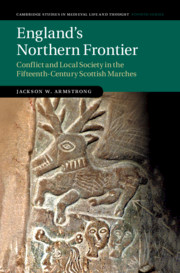Book contents
- England’s Northern Frontier
- Cambridge Studies in Medieval Life and Thought
- England’s Northern Frontier
- Copyright page
- Dedication
- Contents
- Figures
- Maps
- Acknowledgements
- Abbreviations
- 1 Introduction
- Part I
- Part II
- Part III
- 6 The Administration of Justice
- 7 Patterns of Conflict
- 8 Cross-Border Conflict
- 9 Discord
- 10 Concord
- 11 Conclusions
- Bibliography
- Index
9 - Discord
from Part III
Published online by Cambridge University Press: 30 October 2020
- England’s Northern Frontier
- Cambridge Studies in Medieval Life and Thought
- England’s Northern Frontier
- Copyright page
- Dedication
- Contents
- Figures
- Maps
- Acknowledgements
- Abbreviations
- 1 Introduction
- Part I
- Part II
- Part III
- 6 The Administration of Justice
- 7 Patterns of Conflict
- 8 Cross-Border Conflict
- 9 Discord
- 10 Concord
- 11 Conclusions
- Bibliography
- Index
Summary
This chapter and the one that follows focus on accustomed practices of conflict management in the far north. We have already seen the simultaneous function and vibrancy of the systems of royal justice and border justice in the marches, and in the latter case observed how it emphasised immediacy of action as much as redress and reparation. Here the intention is to look specifically at the extent to which practice and usage in the course of conflict reflected a wider normative system of disputing other than that provided by the king’s law, a system that drew on a similar logic as did march law. In this way specific concern for the type of dispute known as ‘feud’ comes to the foreground of attention. As we have observed, feud, like raiding and kin-based social organisation, has been assumed to be an essential characteristic of a turbulent march society. The conceptual framework provided at the outset of this book comes into sharp focus here, and it will be helpful to summarise it briefly again: conflict is understood as an overarching category of social tension into which, among other phenomena, falls disputing. Conflict can also be viewed as a fundamental frame in which social relationships are created, tested and shattered, thus defining the very groups which participate in it. A specific dispute between parties can be pursued (or ‘processed’) using a variety of methods, and the episodes occurring in the course of a dispute draw deeper relationships of conflict to the surface. Once in the open, these relationships can be used, changed or put away again. Feud is a type of dispute which relies heavily on customary practices of conflict management. We have noted that attempts to construct and wield a general model of feud have proved difficult, and some historians have adopted a fruitful approach to the topic that starts with a working definition, and then looks for related ‘feud-like’ elements, such as words or processes. Taking that lead, the following assumptions about feud, derived from a wide scholarship on the subject, are offered for the purposes of this study. To put it one way, feud is a relationship of hostility between two groups, stemming from a desire to seek redress by vengeance for some perceived wrong and involving (at least) the threat of reciprocal violence. This hostility, however, also holds the potential to be transformed into a lasting, peaceful relationship.
- Type
- Chapter
- Information
- England's Northern FrontierConflict and Local Society in the Fifteenth-Century Scottish Marches, pp. 270 - 307Publisher: Cambridge University PressPrint publication year: 2020

